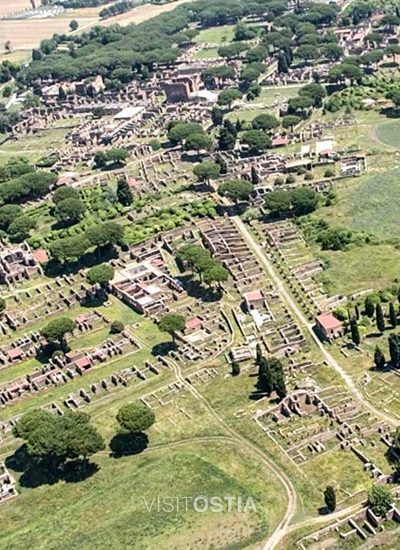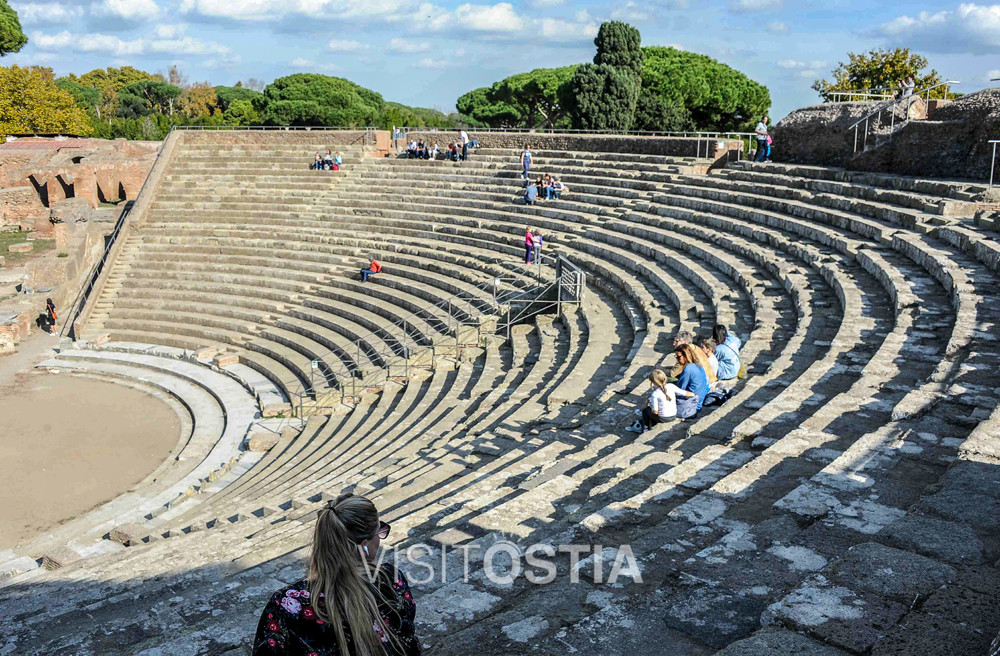The National Archaeological park is between Ostia and Ostia Antica (by train from both Ostia Lido and Rome city centre, Roma-Lido railway, stop at Ostia Antica station) and it is accessible by car using via del Mare or via dei Romagnoli. After Julius II’s castle, direction Ostia, on the right, n. 707 is the entrance.
From the medieval times to the end of the 19 th century, Ostia has been one the world’s most important archeological sites, but it also had to see its monuments plundered by criminals or by other churches. Enormous quantities of objects and materials were taken from Ostia and Rome, to build the Duomo in Pisa between 1063 and 1118, the abbey of Montecassino in 1066, the new St. Peter’s basilica, the basilica in Laterano and many other Roman churches between the 16 th and 17 th centuries. Continuous were also operations in the calcare, rudimental furnaces where the ancient marbles were heated to make lime.

After centuries of occasional findings the first real archaeological excavation was carried out between 1855 and 1869 by Pietro Ercole Visconti, commissioner for Antiquities, entrusted by pope Pius IX. Some of Ostia’s most important monuments saw the light, Magna Mater and the Mamertine baths. At last the excavations were carried out with more attention to history and topography thanks to Carlo Fea and Antonio Nibby. After 1870 the works were directed by Pietro Rosa, while from 1878 it was Rodolfo Lanciani’s turn. His tireless work produced a lot of researches , which were a great starting point for further works. Ostia’s first supervisor was Dante Veglieri who excavated regularly between 1907 and 1912 in the ancient city. Following a precise plan, the tests carried out previously were connected and so the Decumanus Maximus was revealed for the first time. It was Ostia’s most important road. Roberto Paribeni and Guido Calza went on working there until 1946.
Recently, thanks to new techniques and to experts and supervisors who really dedicated, many more buildings and areas were found and brought to light.
The ruins of Ostia Antica
Just past the ticket office on the left hand side of the road, along the Roman road, you start seeing the necropolis, which was external to the city walls, like the law imposed at the time.
The tomb of the Archetti, built with polychrome brick and the tomb of Domizio Fabio Ermogene, secretary of the judicial offices, are really interesting.
Back on via Ostiense you arrive to Porta Romana. It is an opening in the walls built in opus incertum dated I century b.C. from here it changes name turning into Decumanus Maximus becoming the most important road of the city (1.2 km ling, 9 mt wide). Right on the left is piazzale della Vittoria with the statue of Minerva and a great monumental nymphaeum.
On your right find the Republican Stores, the northern part, in the II century b.C. was changed into a thermal bath, le Terme dei Cisiarii. Further on Neptune’s thermal bath, with its fantastic mosaics with the bridal procession of Neptune and Amphitrite.
After you find the fire brigade’s building (II century) with a floor on which some scenes of a sacrifice are visible. On the left is via della Fullonica (the laundry). After via della Fontana which end in the Caupona di Fortunato (hostel) open on the Decumanus, near the theatre there is another building, built on one of the two nymphaeums. It is a small Christian oratory referred to the martyrdom of some Christians near the arch of the theatre. The arch was dedicated to Caracalla in 216 and venerated in medieval time as St. Ciriaco.
The entrance to the theatre is between two stores through the main access or along two flights of stairs in travertine which are more lateral. It could host up to 4.000 people. It was built by Agrippa, restored by Commolo, Septimius Severus and Caracalla as you can see on an inscription.
Only two columns remain of the stage and some masques in marble. Behind it you can find piazzale delle Corporazioni, with Ceres’ temple in the middle. It is a rectangular square (107 x 78 mt). on three sides there are 61 rooms with a portico all along. These rooms are ‘stationes’, commercial offices for import and export companies and ship owners. Every floor had a mosaic referred to the nationality of the owner and which goods he dealt with.
Westward is Apuleio’s Domus (II century) in the style of Pompeii. It is right next to the Mithraeum of the seven spheres, one of the best preserved ones among the 18 in Ostia. At the entrance there is a hole on the floor used to collect the blood of the victims of the initiation ceremonies. Opposite are two republican temples. Further on is via dei Molini, named after the mills to grind wheat, they are next to the horrea, big warehouses for food. It crosses via di Diana, where Diana’s house is with a drop down balcony. In piazzetta dei Lari you can see the remains of the walls of the castrum. On the same road you find the thermopolium and the inn (called by the Romans, popina).
You then turn right in via dei Balconi and you arrive at Ostia’s museum, where you can admire one of the most incredible collections of Roman art. there are many interesting evidences of daily life (statues, busts, reliefs and sarcophagis) and fragments of paintings of priceless historic and artistic value.
Back on the Decumanus where it crosses the other main road of the city, the Cardo Maximus. Here the Forum, with the Capitolium dedicated to Jupiter, Juno and Minerva, a basilica, the Curia. The temple of Rome and Augustus behind which were the grand thermal baths of the forum.
From here the Cardo Maximus goes eastwards towards the Laurentina plain. On the right the Domus of Thundering Jupiter, the Domus with the Mosaic niche, the Nymphaeus of the Cupids, the Domus of the columns, all overlook the road.
From via della Caupona del Pavone, you arrive to the homonymous inn and to the Domus of the Fish. Going straight you meet Hercules’ portico and the baths of the Lighthouse, with a mosaic representing Ostia’s lighthouse. At the end you arrive to Magna Mater Campus, with Attis’ sacellum and the Deudrophori’s house. Passing Porta Laurentina, you leave the city.
Going backwards along the Cardo, on the right there is the Semita of the Cippi, which is the only Roman road of which we certainly know the name thanks to an inscription ‘haec semita hor(rerorum) est’, that is ‘this is the road of the warehouses’.
Back in the forum and going on the left you arrive to the western porta of the Castrum, here we can see other walls of the republican period. Beyond this point de Decumano turns left towards the old beach. Outside the porta you find a very important junction: on the left the Decumanus arrives to Porta Marina, after which was the beach and on the right there is via della Foce, that arrived at the mouth of the river, where Tor Boacciana is. From this junction a road on the right brings to Horrea Epagathiana, which is a private warehouse with a magnificent portal in bricks. In front of this junction there is a sacred republican area with the grand Hercules’ temple and other dedicated to other water gods. Next to this you find the Domus of Love and Psyche, covered with precious marbles.
Along via della Foce you turn right where Mithras’ baths are, an evocative underground mithraeum with hot water and heating systems. Next to it is the temple of the wheat measurers, with an interesting mosaic and a huge warehouse. In the same area you have the house of Baccus and Arianna, the Serapeum (unveiled on 24 th January 127, Hadrian’s birthday), the Trinacria baths, Sepande’s Insula, where you find the thermal complex of the Seven Wise Men characterized by a big round room with a vaulted ceiling and a mosaic floor with hunting scenes and walls with frescoes.
From the baths you arrive to the Insula of the Charioteers and from the Cardo you arrive to via delle Volte Dipinte. Nearby there is a block of houses: the House of the Painted Vaults, the Muses’ Insula, the Yellow Wall Insula all characterized by splendid wall decorations.
Towards the border of the site, near the river’s mouth, are the rests of the Imperial Palace of the first half of the II century. Then you see the Domus of Dioscuri and the Domus of the Nymphaeum, both with polychromatic mosaics on the floor and the Sea thermal baths.
Back on the Decumanus near Porta Marina are the remains of some republican mausoleums (the most important is the one dedicated to Cartilio Poplicola). The thermal baths of Porta Marina (with an ancient inscription on it with its name Thermae Maritimae) and the opus sectile building. On the left the Bona Dea sanctuary and Domus Fulminata. Outside the porta on the left are the remains of a synagogue.
Back on the Decumanus and towards the city centre you can see Trajan’s school and the Six Columns thermal baths. On the other side is a Christian basilica, with two naves and a baptistery. On the left is vico di Dioniso which arrives to the House of the Eagle, to dionysus’ house and to Mythraeum of the Seven Doors.
Out of the site, go right along via dei Romagnoli. After about 1 km you have a crossroad with via Guido Calza. On the parallel part of via del Mare is the entrance to via Laurentina’s necropolis, the second one in Ostia Antica, which is not open to the public.
Excerpt from: S. Lorenzatti (a cura di), Ostia. Storia, ambiente, itinerari, Roma 2007








